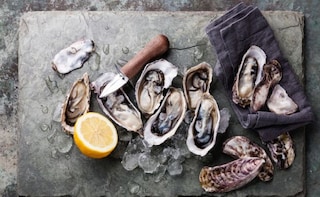It isn't surprising to come across people who refer to oysters as 'overrated'. The argument put forth is that why should one pay such a steep price for a few shells when they taste nothing more than salt water. Yet we all know that it is a prestigious ingredient in the world of fine dining, so that builds up the curiosity nevertheless. There has to be some reason, isn't it?If you have travelled along the coastline of France or visited a few coastal cities in the USA, Australia, UK, Caribbean, et al, you realise that shell fish, particularly mussels and oysters, are a given. No one turns a head if you order a plate of oysters. Instead you are spoilt with multiple options to delight your taste buds. And then, you start to unravel all the frills to discover the humble ingredient for what it's really worth. It is "a taste of the sea" but definitely more than just salt water.
4. Kumamoto - small-sized with bowl-shaped shell, sweet and nutty in flavour, a native of Japan though largely cultivated in US.
5. Olympia - they are tiny-sized, almost the size of a quarter, native to the West Coast of US, sweet in flavour with a metallic note, creamy in texture.
6. Rock Oyster - popularly known as Sydney rock oyster, is small sized, sweet and fruity in flavour, and chewy in texture.
Other than that, oysters are also used in making fritters, as fillings, bakes, grilled, etc. In India, you can find oysters along the coast of Kerala, where the locals prepare it with local spice mixes to make stir-fries and curries. So gear yourself and get a taste of the sea. You'll surely be in for a pleasant surprise.
Advertisement
Advertisement
4. Kumamoto - small-sized with bowl-shaped shell, sweet and nutty in flavour, a native of Japan though largely cultivated in US.
5. Olympia - they are tiny-sized, almost the size of a quarter, native to the West Coast of US, sweet in flavour with a metallic note, creamy in texture.
Advertisement
6. Rock Oyster - popularly known as Sydney rock oyster, is small sized, sweet and fruity in flavour, and chewy in texture.
Other than that, oysters are also used in making fritters, as fillings, bakes, grilled, etc. In India, you can find oysters along the coast of Kerala, where the locals prepare it with local spice mixes to make stir-fries and curries. So gear yourself and get a taste of the sea. You'll surely be in for a pleasant surprise.
For the latest food news, health tips and recipes, like us on Facebook or follow us on Twitter and YouTube.
Advertisement
